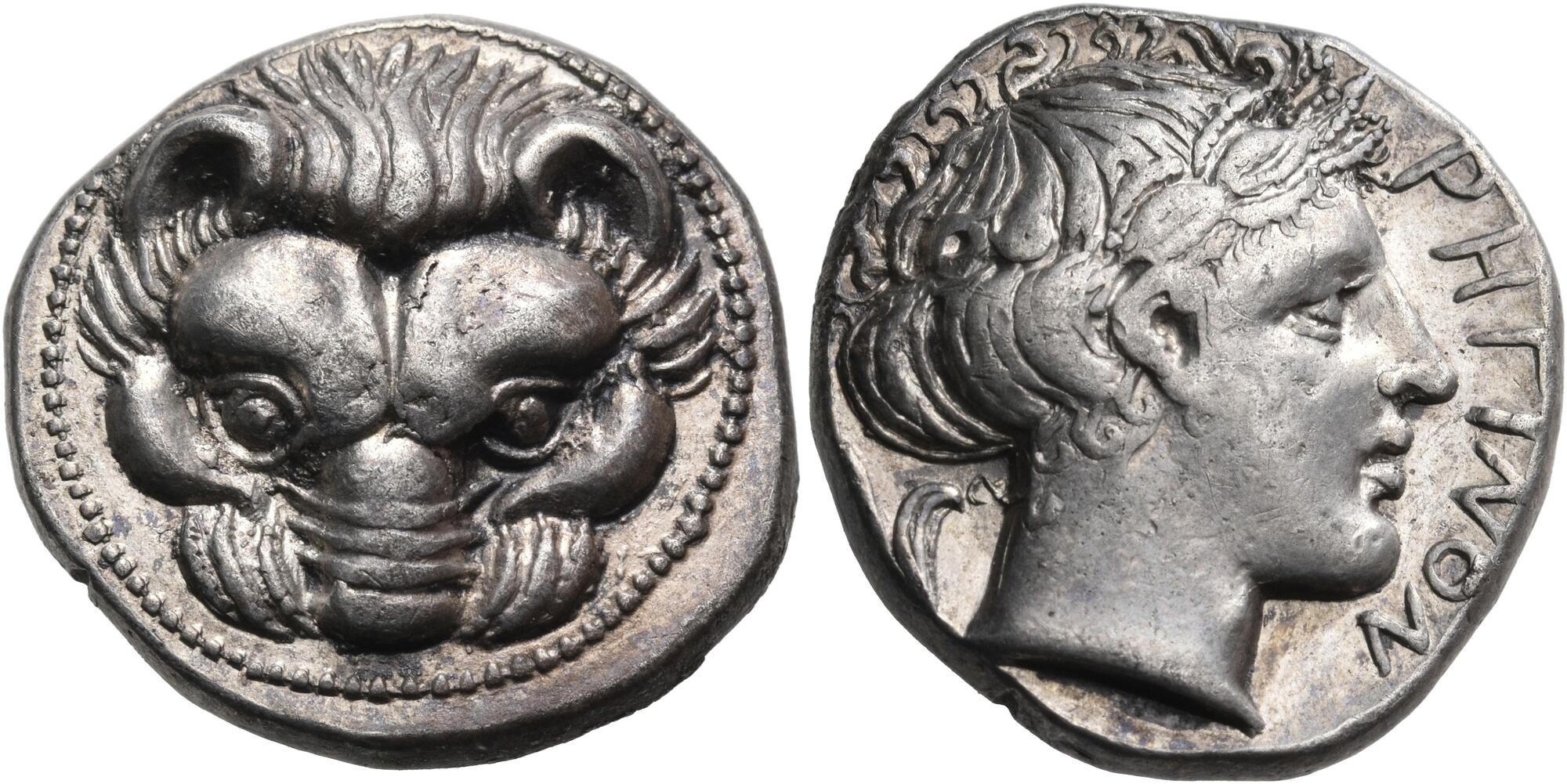Rhegium, silver, tetradrachms (420-387 BCE)
From SILVER
420 BCE - 387 BCE Silver 9,891 kg
Description
| ObverseInscription or printing placed on the obverse.: | Lion's mask facing, border dots |
| ReverseInscription or printing placed on the reverse.: | PHΓINON (Greek).Laureate head of Apollo to right, with olive sprig behind |
Mint and issuing power
| MintIdentifies the place of manufacture or issue of a numismatic object.: | Rhegium | Ancient regionAncient region.: | Bruttium | Modern countryModern country: Italy | AuthorityIdentifies the issuing power. The authority can be "pretended" when the name or the portrait of X is on the coin but he/she was not the issuing power. It can also be "uncertain" when there is no mention of X on the coin but he/she was the issuing power according to the historical sources: |
Chronology
| FromIdentifies the initial date in a range assigned in a numismatic context. | 420 BCE | toIdentifies the final date in a range assigned in a numismatic context.. | 387 BCE | PeriodTime period of the numismatic object.: Classical 480-323 BC |
Physical description
| MetalThe physical material (usually metal) from which an object is made.: | Silver |
Median weightMedian of the weights of numismatic objects (in grams). in grams | 17.25 | DenominationTerm indicating the value of a numismatic object. Examples: tetradrachm, chalkous, denarius.: | tetradrachm |
StandardStandard.: | Attic |
Image

AC 36 - Rhegium, silver, tetradrachm, 420-387 BC.jpg [1]
References
| Die study referencePublication of the study: | Herzfelder 19571Herzfelder 1957, deuxième série. | ||
| Coin series referenceReference to coin series study: | Sear I2Sear I, n° 501, RQEMAC3RQEMAC, n° 36, HN Italy4HN Italy, n° 2496-2497, HGC 15HGC 1, n° 1638 | ||
| Coin series web referenceCoin series web references: | |||
Obverse dies distribution
| FrequencyFrequency of specimen in distribution. ᵖ | Number of obversesNumber of obverse dies. ᵖ (o) | % (o) | Number of coinsNumber of coins. (n) | % (n) | Die nameName(s) of the die(s). |
| 1 | 3 | 11.11 | 3 | 1.68 | 41, 51, 52 |
| 2 | 4 | 14.81 | 8 | 4.47 | 45, 48, 53, 57 |
| 3 | 1 | 3.7 | 3 | 1.68 | 49 |
| 4 | 3 | 11.11 | 12 | 6.7 | 38, 43, 50 |
| 5 | 2 | 7.41 | 10 | 5.59 | 39, 6 |
| 6 | 2 | 7.41 | 12 | 6.7 | 46, 58 |
| 7 | 2 | 7.41 | 14 | 7.82 | 47, 59 |
| 8 | 1 | 3.7 | 8 | 4.47 | 40 |
| 9 | 3 | 11.11 | 27 | 15.08 | 44;55;62 |
| 10 | 2 | 7.41 | 20 | 11.17 | 37, 61 |
| 11 | 1 | 3.7 | 11 | 6.15 | 42 |
| 13 | 1 | 3.7 | 13 | 7.26 | 36 |
| 18 | 1 | 3.7 | 18 | 10.06 | 56 |
| 20 | 1 | 3.7 | 20 | 11.17 | 54 |
| Total | 27 of 27 | 99.98 | 179 of 179 | 100 |
Reverse dies distribution
no distribution is available
Quantification
| Number of obversesNumber of obverse dies. ᵖ (o) | 27 | Number of singletons (o1)The number of singleton coins. ᵖ | 3 |
| Number of reverse diesNumber of reverse dies. (r) | 42 | Number of coinsNumber of coins. (n) | 179 |
| Coins per obverse dieNumber of coins per obverse die. (n/o) | 6.63 | Coins per reverse dieNumber of coins per reverse die. (n/r) | 4.26 |
| Reverse per obverse ratioRatio of obverse dies divided by reverse dies. (r/o) | 1.56 | Percentage of singletons (o1)number of coins (n) divided by the number of singletons (o1) ᵖ | 11.11 % |
| Original number of dies (O) (Carter 1983 formula)The estimation of the number of coins according to Carter 1983 ᵖ | 28.67 | Coins struck if 20,000 as average productivity per dieCoins made if the average productivity for obverses (according to Carter) is 20,000. ᵖ | 573,400 |
| Original number of dies (O) (Esty 2011 formula)The estimation of the number of coins according to the singleton formula in Esty 2011 ᵖ (O) | 31.8 | Survival rate if 20,000 as average productivity per dieSurvival rate if average productivity is 20,000. ᵖ | 0.00031 |
| Coverage (o = % of O) (Esty 1984 formula)Esty 1984 - coverage (% of O) ᵖ (o = % of O) | 98.32% | Die productivity if survival rate 1/2,000Average productivity if survival rate is 1/2,000. ᵖ | 12,486.92 |
| Weight of silver (in kg) if 20,000 coins per die (O = Carter formula)Carter 1983 * Median weight * 20000 (*10 if gold or electrum) ᵖ | 9,891 kg <br /> 9,891 kg | Die productivity if survival rate 1/5,000Average productivity if survival rate is 1/5,000. ᵖ | 31,217.3 |
Remarks